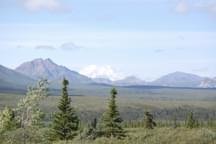The bluff at the end of the campground was my favorite. High above the fast-flowing river; the bluff stood tall and proud. Standing on that magical bluff thoughts wander from the present song of the white crowned sparrow to a time in the ancient past when there was a young Athabaskan woman sitting by her fire.
She was pleased to have the heavy iron pot her mate had been able to get in trade. Although no one from her family ever had any contact with outsiders, her spouse and some others traded with natives from the south who did have contact with Europeans and were thus able to get things like her pot.
The subarctic boreal forest is surrounded by mountain ranges which made the interior difficult to penetrate by early explorers. The young couple lived on the banks of Jenny Creek near the bluff. They learned to adapt to this harsh climate while they took part in establishing a rich culture uniquely their own in the world.
These people lived mainly near rivers. The rivers were then and continue to be a source of food and travel. In the winter the frozen rivers become roads. In the summer months the couple joins others to hunt, fish, and gather, but when the harsh winter months come it is too difficult to provide for large groups, and so they split up and struggle for survival until the warm months of plenty return.
Although her life was difficult in these winter months, she loved the nights when the sky was full of light. It seemed to her that the sky came alive with color starting with a flowing movement of green and sometimes other colors emerged – a light show of amazing proportions.
Everyone worked hard in this environment in order to get enough food just to stay alive – and they made use of every bit of what they harvested. When her mate killed a caribou, our young native wife helped to skin the animal, and every part of the animal was put to use.
She would of course cook the meat for immediate consumption, and some was dried for future use. The bones and antlers were made into tools and weapons. The skin was used as clothing, bedding, and stretched over wood frames for shelter. Sometimes the skin was cut into strips called babiche and used to make snowshoes.
Her spouse believed that he was connected to the land and the animals not only physically, but spiritually. Although his belief system was complex, he essentially believed that all living things and some inanimate ones have a spirit.
Our hunter knew that relationships between men and animals were a key to survival, and he took care not to offend the spirits of the animals they relied on for food, clothing and shelter. Some animals have a stronger spirit than others such as the wolf, the bear, the caribou, and especially the wolverine.
Spirits lived on after physical death, and those spirits had power. Our hunter took steps to avoid making the spirit of an animal angry, because if he angered the spirit of the animal, he would not have luck in capturing the animal in the future.
Ravens were good hunting companions. They sometimes flew toward game; if the hunter followed the sign of the raven, he was likely to be lucky in his hunt. It is said the ravens did this in order to get their share in what the hunter left behind.
Out there on the bluff I am startled back to reality by sounds coming from below. I see a mother grizzly bear and her cub. They are digging up and eating the roots of a plant colloquially known as Eskimo potato. Thankfully they have not seen me. I wish I could stay and continue my daydream, but I have intruded on their environment, and therefore I quietly back away.
I left the comfort of my easy chair in a small tourist town and learned that I could meet the challenge of living in a place where the animals were plentiful, wild, and free. I faced up to a moose with my little dog. Grizzly bears passing through the campground were not uncommon. Lynx roamed like alley cats, and we saw wolves and more often signs of wolves in and around camp.
It is a big wild place and suitably is home to big wild animals. It’s also home to people who chose to live in harmony with the wildlife. The people and animals of the present and the people of the past have made a mark on our hearts providing unforgettable memories of the journey.


